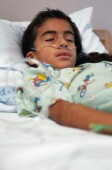
WEDNESDAY, April 11 (HealthDay News) — Additional chemotherapy may a better option than bone marrow transplant for some children with acute lymphoblastic leukemia who don’t respond to an initial intense regimen of chemotherapy called “induction therapy,” a new study says.
Acute lymphoblastic leukemia, or ALL, is a cancer of the blood and bone marrow.
According to study co-author Dr. Ching-Hon Pui, failure to improve after induction therapy is rare, happening in just 2 percent to 3 percent of children with ALL. But when it does happen, these children’s risk for a bad outcome rises considerably, so they often then become candidates for a bone marrow transplant.
However, the new study suggests that that option may not always be the only one.
“Some patients and their parents will be relieved to know that transplantation is not necessary for cure,” said Pui, chair of the oncology department at St. Jude Children’s Research Hospital in Memphis, Tenn. His team published their findings in the April 12 issue of the New England Journal of Medicine.
In the study, Pui and his colleagues tracked more than 1,000 children with ALL who did not go into remission after four to six weeks of induction therapy. The patients’ cancer was diagnosed when they were between the ages of 1 to 5 years.
The overall survival rate for children with ALL who fail to go into remission following induction therapy was 32 percent. However, the rate was 72 percent in a subset of patients who had additional chemotherapy instead of a bone marrow transplant.
Pui’s group noted that this type of patient had a form of ALL that begins in white blood cells destined to become B cells (B-lineage ALL). They accounted for about 25 percent of the more than 1,000 patients who did not go into remission following induction therapy.
Patients who fail induction therapy but may not require transplant, therefore, “are the patients who have B-cell precursor leukemia with no other adverse features,” Pui said. “The remaining patients [who failed induction therapy] will be certain that transplantation is their best treatment for cure.”
Another expert in leukemia care said the study offers valuable information.
“The study shows that even in these patients who have a poor response, there are a few subgroups that ultimately do well while there are other subgroups that do poorly and need bone marrow transplantation,” said Dr. Arlene Redner, associate chief of oncology at Steven and Alexandra Cohen Children’s Medical Center of New York in New Hyde Park, N.Y.
“This study will allow us to tailor our therapy in these patients and know that some of the patients who don’t go into remission after the first month of therapy need bone marrow transplantation while others do not,” she explained.
Still, the study did have its limits, Redner added. “The problems with the study are that the children were not all treated the same way and were treated over a long time period from 1985 and 2000. We now subdivide patients and treat them differently than during that time period.”
More information
The U.S. National Cancer Institute has more about childhood acute lymphoblastic leukemia.

